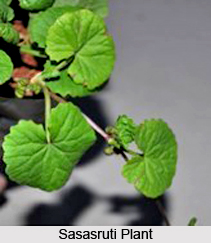 Sasasruti is an Indian plant known for its immense medicinal values. It is well admired in many states for serving as a substitute for capsules or bitter tasting medicines. The scientific name of Sasasruti is Emilia sonchifolia. It is commonly known as `Sudhimudi` in Bengali, `Hirankhuri` in Hindi, `Mulshevi` in Malayalam and `Sadamandi` in Marathi.
Sasasruti is an Indian plant known for its immense medicinal values. It is well admired in many states for serving as a substitute for capsules or bitter tasting medicines. The scientific name of Sasasruti is Emilia sonchifolia. It is commonly known as `Sudhimudi` in Bengali, `Hirankhuri` in Hindi, `Mulshevi` in Malayalam and `Sadamandi` in Marathi.
Habitat of Sasasruti
Sasasruti plant is found in most tropical and subtropical regions worldwide. Though the plant is well admired in India for its medicinal properties, the plant is also praised outside India for its immense potential validity over pharmaceutical products. This plant is commonly found in cultivated fields and other open, disturbed habitats throughout most of India up to 1200 metre elevation.
Characteristic Features of Sasasruti
Sasasruti plant is a slender, erect or diffuse annual herb that grows up to 40 cm. Leaves are variable as the lower is petioled, lyrate or obovate, toothed or entire and the upper or the cauline leaves are more or less amplexicaul and auricled and are usually acute. The flowers have pink or purplish tint, borne in solitary or corymbose heads up to 1.3 cm long. The peduncles are very slender and are nodding at the young stage. The involucre is cylindrical and the bracts are almost equalized to the corolla, linear-oblong and are acute. The fruits are 0.3 cm long, narrowly oblong, 5-ribbed and brown in colour. Scabrid is found on the ribs, attached to a white and soft pappus. The Sasasruti plant generally bears flowers and fruits between September and December.
Medicinal Uses of Sasasruti
Having vast medicinal value, Ayurveda considers the Sasasruti plant for the preparation of medicines. This plant is sudorific and is applied to relieve cuts and wounds. The tribal women in western Maharashtra use crushed leaves externally to relieve breast abscesses. The juice of the fresh leaves is used to relieve sore ears, sore eyes and night blindness. This plant is reportedly said to have the curing properties of headache. The tribal inhabitants of Surguja District in eastern Madhya Pradesh rub the leaves of the plant to get relief from headache. A decoction of the plant is used as a febrifuge to treat infantile tympanites. Sometimes the infusion of the Sasasruti plant is mixed with sugar for bowel complaints. The root of the plant is used to treat Diarrhoea. The root juice, mixed with salt and water, is used to treat cataracts and redness of the eyes.
Culinary Uses of Sasasruti
The Sasasruti plant also serves the culinary purpose. The stem-leaves are cooked and eaten as a vegetable by the people of many states. In some tribal places this plant is eaten with rice though they have a slightly bitter, acidic but delicate flavour. This herb is used as a salad plant before flowering.



















